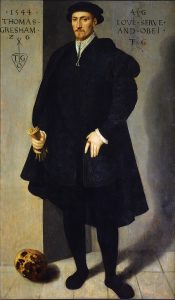Gresham, Gresham Street, Gresham College and the Royal Exchange: Familiar names to bankers
Adding to our recent blogs about central banks and bankers, and there’ll be more fun when Madame Christine Lagarde takes the helm at the European Central Bank, I wanted to give you a peek into the controversial and fabulous life of Sir Thomas Gresham the Elder (1519-1579). In those 60 years he managed to be banker to King Edward VI, and his half-sisters Queens Mary I and Elizabeth I, for almost four decades.
St Paul’s School and Gonville & Caius College educated, liveryman in the Mercer’s Company, he followed in his father Richard’s footsteps, the ruthless fixer for King Henry VIII who’s said to be ‘’one of the most hated men in London’’ – because he had debased the coinage and defaulted on increasingly expensive loans to support the king’s excesses.
 Thomas was the first Englishman on Amsterdam’s Bourse to use double-entry bookkeeping, tracking his trades and the money he smuggled to Henry VIII. Then, proposing to new King Edward VI how ‘’his majesty could grow out of debt’’, with currency and market manipulation, a ban on travel to the Low Countries (where he was smuggling commodities on a grand scale), and the export restrictions he imposed, he halved the king’s debt in nine months.
Thomas was the first Englishman on Amsterdam’s Bourse to use double-entry bookkeeping, tracking his trades and the money he smuggled to Henry VIII. Then, proposing to new King Edward VI how ‘’his majesty could grow out of debt’’, with currency and market manipulation, a ban on travel to the Low Countries (where he was smuggling commodities on a grand scale), and the export restrictions he imposed, he halved the king’s debt in nine months.
New Queen Elizabeth I, of course, kept on such an able retainer, enabling Gresham to line his own pockets courtesy of yet another monarch. He again debased the currency but, more importantly, shifted State borrowing to London from Europe’s traditional banking centres, and pushed out maturities to reduce the risk of fluctuations in short term interest rates. Endemic smuggling and market rigging continued so that queenie could finance her overseas wars. With his personal profits he built the Royal Exchange, modelled on Amsterdam’s Bourse, opposite the Bank of England (today), and Gresham College, Holborn, London.
Author Guy concludes that Gresham was ‘a harbinger of a world to come: one in which national sovereignty is answerable to the machinations of the market’. Book reviewer Jerry Brotton notes: ‘He married unhappily, lost a son, swindled his brother and son-in-law out of their inheritances, had two affairs and fathered an illegitimate daughter’ – and died with his creditors swarming. All in a day’s work, as they say.
I hope you will be able to open the link to the book review in the Financial Times: https://www.ft.com/content/7943484e-980b-11e9-98b9-e38c177b152f
And if not try The Guardian’s review, here.
Or you might consider buying the book by John Guy, ‘Gresham’s Law: The Life and World of Queen Elizabeth I’s Banker’, a snip at £25 from Profile Books Limited, London.
You might also like ‘The sign of the Golden Grasshopper: Biography of Sir Thomas Gresham’ by Perry E. Gresham.
The views and opinions expressed on the STA’s blog do not necessarily represent those of the Society of Technical Analysts (the “STA”), or of any officer, director or member of the STA. The STA makes no representations as to the accuracy, completeness, or reliability of any information on the blog or found by following any link on blog, and none of the STA, STA Administrative Services or any current or past executive board members are liable for any errors, omissions, or delays in this information or any losses, injuries, or damages arising from its display or use. None of the information on the STA’s blog constitutes investment advice.
Latest Posts
- Avoid Revenge Trading: The Key to Long-Term Trading Success March 31, 2025
- Mastering Relative Strength Portfolios: Key Takeaways from the March STA Meeting March 12, 2025
- Stay Disciplined, Stay Profitable February 26, 2025
- Understanding Price Gaps in Trending February 19, 2025
- Key Takeaways from a Fireside Chat with Perry Kaufman February 12, 2025




















Latest Comments